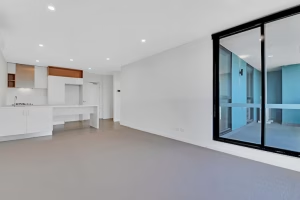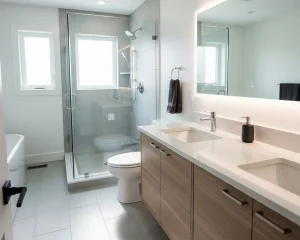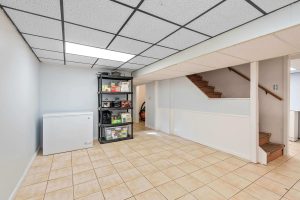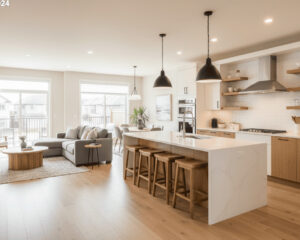If you’re wondering when a renovation permit is required in Edmonton, you’re not alone. Homeowners often start with a clear idea: update a bathroom, finish a basement, open up a wall, but permits, inspections, and municipal rules shape how a project must be planned and delivered. Understanding renovation permit Edmonton requirements early saves time, prevents rework, and protects your property’s resale and insurance position.
This guide explains common permit triggers in Edmonton, the differences between trade permits and building permits, how to apply, what inspectors will look for, and why working with an experienced local contractor like Steadfast Constructions Ltd. makes the process smoother. I’ll also include practical examples, local references, and authoritative links so you can verify the rules yourself.
What kinds of projects typically need a permit?
When homeowners ask, “Do I need a building permit for interior renovations?” the short answer is: it depends on what you’re changing. Edmonton’s rules make a clear distinction between cosmetic work (which often doesn’t require a permit) and work that affects structure, fire safety, or major systems (which usually does). Common projects that trigger a renovation permit in Edmonton include adding or relocating bedrooms and bathrooms, structural changes, adding or resizing windows and exterior doors, and creating a secondary suite.
Typical permit triggers:
- Creating or moving a bedroom, bathroom, or kitchen (including basement suites). edmonton.ca
- Structural changes, such as removing or altering load-bearing walls. edmonton.ca
- Adding or enlarging exterior windows or doors (egress windows included). edmonton.ca
- New or altered plumbing, gas, or electrical systems that require trade permits. safetycodes.ab.ca
Why this matters: a permit signals that the work will be inspected by the municipal authority and meets the Alberta Safety Codes (building, plumbing, electrical, gas), protecting both occupants and future buyers.
Interior renovations and when they do (and don’t) need approval
Not every cosmetic update needs a permit. Simple projects—painting, replacing finishes, installing new cabinets without moving plumbing, often don’t require formal approval. But the moment you change concealed systems or the structure, a permit usually follows.
Common no-permit examples:
- Painting, replacing flooring (if subfloor and structure are unchanged).
- Replacing fixtures in the same location without changing pipes or wiring.
Common permit-required examples:
- Moving a toilet or installing a new bathroom where none existed before.
- Rewiring circuits, adding new outlets on a new circuit, or changing the electrical panel.
- Building new interior walls that change the layout significantly.
If you’re unsure, check the City of Edmonton’s “home improvement permits” page or consult a qualified contractor—mistakes here can lead to stop-work orders or costly corrective work.
Basement renovations, suites, and egress requirements
Basements are a common trigger for permits because they often become bedrooms, bathrooms, or rental suites. Converting an unfinished basement into living space usually requires a building permit and trade permits for plumbing, electrical, and gas, as needed. If you plan to create a legal secondary suite, additional rules apply for egress, fire separation, ventilation, and sometimes separate mechanical systems.
Egress windows and bedroom windows:
Bedrooms typically must have an egress window that meets minimum opening area and clearances so occupants can escape in an emergency. Edmonton’s guidance spells out the required opening size and well clearance.
If you want a rental suite, check both development/zoning rules and building-safety requirements early; some neighbourhoods have specific rules or programs. A professional renovator will confirm zoning and handle permit submissions for you.
Electrical, plumbing, gas, and HVAC
Beyond building permits, many interior renovations need trade-specific permits. In Alberta, these are regulated under the Safety Codes Act and administered by accredited municipalities or inspection agencies.
Key trade permits:
- Electrical permits for new circuits, changes to service panels, or significant rewiring.
- Plumbing permits for moving drains, adding bathrooms, or installing new water services.
- Gas permits for installing or altering gas lines or appliances.
- Mechanical/HVAC permits for changes to heating, ventilation, or exhaust systems.
Licensed tradespeople typically apply for these permits and arrange inspections. That means if you plan to alter core systems, you should hire certified professionals who know the code and can schedule inspections in the right sequence.
Why inspections matter
Inspections verify the work at key milestones, before drywall is installed, after insulation, and at completion, so that hidden systems and safety elements are checked. Passing inspection documents that work to meet code, which helps with insurance claims and resale transparency. If an inspector identifies an issue, a corrective action will be required before moving forward.
Typical inspection milestones:
- Structural/rough framing inspection.
- Plumbing and electrical rough-ins.
- Insulation and vapour barrier inspection.
- Final inspection and occupancy sign-off.
Process and documents
Applying for a renovation permit in Edmonton usually follows a standard sequence: prepare drawings, submit an application, pay fees, and respond to plan-check comments. For complex projects, you’ll often need permit-ready drawings from a designer or engineer.
Step-by-step:
- Confirm permit type: building permit, and any required trade permits. Use City of Edmonton resources to identify the correct application. edmonton.ca
- Prepare documentation: site plan, floor plans, sections, structural notes, and details for egress and fire separations where required. For secondary suites, follow the City’s design guide. edmonton.ca
- Submit application: either online or in person, depending on the city’s system. Include contractor credentials if a registered contractor is applying. edmonton.ca
- Review and revisions: Municipal plan check may request clarifications; respond promptly to avoid delays.
- Permit issuance & inspections: once approved, post the permit and schedule inspections at the required stages.
If this process sounds heavy, it is. Many homeowners hire a contractor or design professional to prepare permit-ready drawings and manage the submission. That ensures code issues are addressed up front.
Documentation you should keep
Keep these documents at the end of the project:
- Permit forms and inspection sign-offs.
- Final approved drawings or as-built drawings.
- Manufacturer warranties for installed systems and appliances.
- Project photos of key assemblies (waterproofing, structural connections).
These documents protect you at resale and make future renovations easier. Steadfast Constructions prepares a project binder with all permit and inspection records at handover for homeowner peace of mind.
Special cases: Heritage homes, exterior work, and decks
Certain projects have extra rules. For example, heritage properties may require heritage approval in addition to building permits. Exterior work, changing rooflines, altering exterior cladding, or adding decks and fences, often requires permits and may need development approval if it affects lot coverage or setbacks.
If your property is in a historically sensitive neighbourhood or on a conservation list, consult the City’s planning office early. A local contractor familiar with Edmonton’s neighbourhoods reduces risk and speeds approvals.
Common pitfalls and how to avoid them
Even experienced homeowners can stumble when dealing with permits. The most common problems include starting work before a permit is issued, incomplete submissions that trigger plan-check rejections, and failing to arrange inspections in sequence.
How to avoid hurdles:
- Confirm permit needs before you start demolition. Starting without permits risks stop-work orders.
- Use permit-ready drawings for complex work; half-baked sketches often get rejected.
- Hire licensed trades for electrical, plumbing, and gas to ensure permits are pulled and inspections are scheduled correctly.
- Keep clear records of communications and a simple project binder with permits and inspection dates.
Many homeowners choose a professional contractor to manage these details because contractors understand municipal expectations and can coordinate multiple trades and inspections efficiently.
Trends and why permits matter now
Renovation activity in Canada remains significant. Statistics Canada tracks renovation price changes across regions and shows renovation activity continuing in the post-pandemic period. That means municipal permit offices see sustained applications, and accurate documentation matters more than ever. Proper permits and inspections protect homeowners and ensure projects meet modern safety and energy standards.
At the same time, federal and provincial programs that support secondary suites and rental-friendly housing make it a good time to consider legal conversions, but those also emphasize compliance with permit and inspection requirements. If you plan a basement suite, verify both development zoning and building safety rules early.
Working with a contractor to manage permits
A full-service contractor handles permits as part of project management; this is where professional renovation services deliver real value. When interviewing contractors, ask:
- Do you manage permit applications and municipal plan check responses?
- Can you show examples of recent permitted projects in Edmonton (basements, additions, kitchens, bathrooms)?
- How do you schedule inspections and manage trade sequencing?
- Will you provide the final permit and inspection binder at handover?
Programs like RenoMark help homeowners find renovators who follow a renovation-specific code of conduct and provide consumer protections. Look for renovators who belong to respected industry associations.
Steadfast Constructions Ltd. manages permit-ready drawings, submits applications, coordinates licensed trades, and keeps inspection schedules on track. That single-point accountability reduces homeowner stress and keeps the project moving.
What to expect at final sign-off
A successful permit process ends with final inspections and sign-off. The inspector verifies that required systems and assemblies meet code and that final safety items, egress paths, smoke detectors, and ventilation are in place. Keep the final permit and inspection documents with your home records; they confirm that the work was legal and inspected.
Summary checklist before you start
Use this short checklist to confirm you’re ready to begin:
- Confirm whether your scope triggers a renovation permit in Edmonton (structure, plumbing, gas, electrical, or new bedrooms/bathrooms). edmonton.ca
- If a permit is required, arrange permit-ready drawings or ask your contractor to prepare them. edmonton.ca
- Hire licensed trades for plumbing, electrical, and gas permits. safetycodes.ab.ca
- Schedule inspections and keep a project binder with all permit and inspection records.
- If you’re planning a secondary suite or major basement work, confirm zoning and egress requirements early. edmonton.ca
Conclusion
Knowing when a renovation permit in Edmonton is required removes a lot of guesswork from home projects. Permits protect your family, your investment, and future buyers by ensuring work is inspected and built to Alberta’s safety codes. Start every renovation by clarifying whether permits are needed, preparing permit-ready drawings for complex work, and hiring licensed trades for plumbing, electrical, and gas. If the permit process feels daunting, a local contractor who manages permitting and inspections will save time and reduce risk.
Steadfast Constructions Ltd. helps Edmonton homeowners manage permits from start to finish. We prepare permit-ready drawings, submit applications, coordinate licensed trades, and bring projects to final sign-off, then provide a complete project binder at handover. If you’re planning a kitchen, bathroom, basement, or addition and want a partner who knows Edmonton’s permit process, contact Steadfast Constructions Ltd. to schedule a consultation. We’ll review your plans, confirm permit triggers, and outline the steps to a safe, inspected renovation.
Frequently Asked Questions (FAQs)
Q1: Do I need a renovation permit in Edmonton to finish my basement?
A1: In most cases, yes. Finishing a basement into a living space, adding bedrooms or bathrooms, or creating a secondary suite typically requires a building permit and trade permits for plumbing, electrical, and gas, where applicable. Check the City of Edmonton’s guidance and the Secondary Suite Design Guide for specific requirements.
Q2: How do I apply for a building permit for renovation in Edmonton?
A2: Prepare permit-ready drawings (site plan, floor plans, and structural details as needed), then apply to the City of Edmonton or your accredited inspection agency. A contractor or design professional can submit on your behalf and respond to plan-check questions.
Q3: Will I need separate permits for electrical, plumbing, and gas?
A3: Yes. In Alberta, trade permits are managed under the Safety Codes Act; electrical, plumbing, and gas work typically require separate permits and inspections carried out by licensed trades.
Q4: What happens if I start work without a permit?
A4: Starting without required permits can result in stop-work orders, rework to meet code, difficulties at resale and potential insurance complications. If you’re unsure whether a permit is needed, consult the City of Edmonton or a qualified local contractor before work begins.
Q5: How can a contractor help with the renovation permit process in Edmonton?
A5: A contractor experienced with Edmonton’s permitting process prepares permit-ready drawings, submits applications, coordinates licensed trades, schedules inspections, and compiles final documentation. This single-point responsibility reduces delays and increases the chance of a clean, inspected final sign-off. Steadfast Constructions Ltd. provides this full-service support for Edmonton homeowners.







